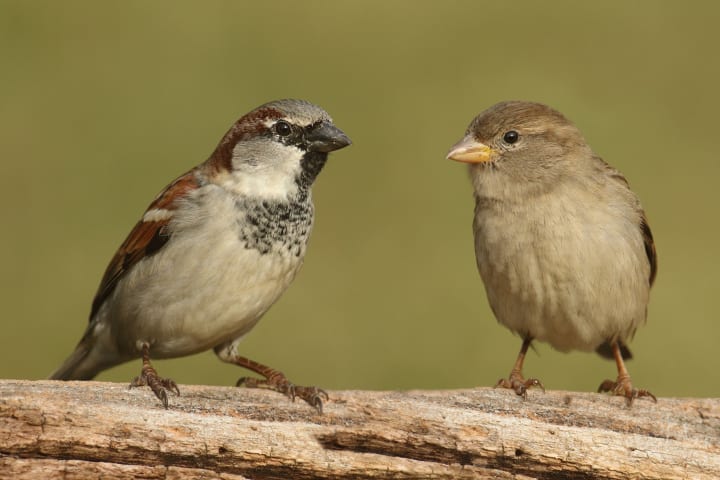
The House Sparrow (Passer domesticus) is a small bird with a rich and complex history deeply intertwined with human civilization. In 1000 words, let's delve into its fascinating journey.
Belonging to the family Passeridae, the House Sparrow has been a ubiquitous presence in human settlements for thousands of years. Originating in the Middle East, this adaptable bird has spread across the globe, establishing itself as one of the most common and recognizable avian species.
The relationship between humans and House Sparrows dates back to ancient times. These birds were attracted to the scraps and refuse around early human settlements, finding a consistent source of food amidst human activity. As agriculture developed, House Sparrows followed, feasting on grains and seeds in fields and barns.
Throughout history, House Sparrows have been celebrated and reviled. In ancient Rome, they were considered a symbol of good luck and fertility, often depicted in art and literature. However, as human populations grew and urbanization intensified, House Sparrows became viewed as pests, nesting in buildings and competing with humans for resources.
The colonization of the Americas in the 16th century marked a significant turning point for House Sparrows. European settlers inadvertently introduced these birds to new territories, where they quickly established thriving populations. Their adaptability to diverse environments and reproductive prowess allowed them to spread rapidly across North and South America.
By the 19th century, House Sparrows had become a common sight in cities worldwide, earning them the moniker "the birds of civilization." Their association with human activity led to their inclusion in countless works of literature, art, and folklore, symbolizing both the comforts and challenges of urban life.

However, the widespread success of House Sparrows has not been without controversy. As they continued to expand their range, they began to outcompete native bird species for food and nesting sites. In some regions, their aggressive behavior towards other birds has led to concerns about declining biodiversity.
The 20th century brought both challenges and opportunities for House Sparrows. Urbanization and the proliferation of agriculture provided abundant food sources and nesting sites, fueling population growth. However, changing land-use practices and the decline of traditional farming methods have also posed threats to their habitat.
In recent decades, researchers have sought to understand the factors influencing House Sparrow populations. Studies have highlighted the role of urbanization, pollution, habitat loss, and climate change in shaping the distribution and abundance of these birds. Conservation efforts have focused on creating green spaces in urban areas, reducing pesticide use, and promoting awareness of the importance of biodiversity.
Despite these challenges, House Sparrows remain a resilient and adaptable species, capable of thriving in a wide range of environments. Their continued presence serves as a reminder of the complex and interconnected relationship between humans and the natural world.
In conclusion, the House Sparrow's history is a testament to its remarkable ability to coexist with humans while adapting to changing environments. From ancient settlements to modern cities, these birds have been constant companions, embodying both the challenges and opportunities of urban life. As we navigate the complexities of conservation and biodiversity in the 21st century, the story of the House Sparrow serves as a poignant reminder of our shared responsibility to protect and preserve the natural world.
The House Sparrow (Passer domesticus) has a fascinating history intertwined with human civilization. Here's a brief overview of its evolutionary background, domestication, and spread:
Origins and Evolution:
The House Sparrow is native to the Middle East and has a long history of association with humans. Its natural habitat includes grasslands, savannas, and urban areas. The species belongs to the family Passeridae and the order Passeriformes, which includes many small, perching birds.
Domestication and Association with Humans:
The House Sparrow has been closely associated with human settlements for centuries. Its adaptability to urban environments and its dependence on human activities for food and shelter have contributed to its success in cohabiting with humans. As agriculture and permanent human settlements expanded, so did the House Sparrow's range.
Spread Around the World:
The House Sparrow's association with humans facilitated its spread to various parts of the world. Humans unintentionally introduced the species to new areas during explorations, trade, and colonization. House Sparrows were intentionally introduced to North America, South America, Australia, and other regions as a form of pest control and to provide a sense of familiarity to settlers.
Behavior and Adaptations:
House Sparrows are highly adaptable and opportunistic in their feeding habits. They primarily feed on seeds, grains, and insects. Their ability to exploit a wide range of food sources has contributed to their success in urban and agricultural environments.
Conservation Status:
Despite being widespread and abundant in many areas, House Sparrow populations have faced declines in some urban areas, particularly in parts of Europe. The reasons for these declines are complex and may include changes in urban landscapes, pollution, and competition for nesting sites. The decline of House Sparrows in certain regions has led to conservation efforts to understand and mitigate the factors affecting their populations.
Cultural Significance:
The House Sparrow has cultural significance in various societies. It is often featured in literature, art, and folklore, symbolizing traits such as adaptability, familiarity, and sometimes even mischief.
The House Sparrow's history is a testament to the complex relationship between humans and the natural world, highlighting the ways in which certain species have adapted to and thrived in anthropogenic environments.






Comments
There are no comments for this story
Be the first to respond and start the conversation.